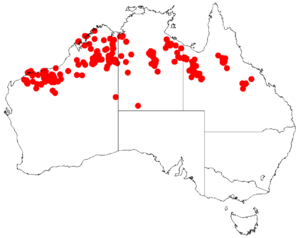Acacia orthocarpa facts for kids
Quick facts for kids Acacia orthocarpa |
|
|---|---|
| Scientific classification | |
| Genus: |
Acacia
|
| Species: |
orthocarpa
|
 |
|
| Occurrence data from AVH | |
Acacia orthocarpa, also known as the Pilbara weeping wattle, needle-leaf wattle, or straight-podded wattle, is a special kind of shrub or small tree. It belongs to the Acacia family, which is famous for its many wattle species. This plant is endemic, meaning it only grows naturally in tropical parts of northern Australia. The local Nyangumarta people call it yartupu.
Contents
About the Pilbara Weeping Wattle
This plant usually grows as an upright, spreading shrub or a small tree. It can reach a height of about 0.9 to 4 meters (3 to 13 feet). Often, its branches hang down, giving it a "weeping" look. Sometimes, it can also grow as a low, bushy plant.
What Does It Look Like?
The bark of the Pilbara weeping wattle is dark grey to grey-brown. It can be smooth or a bit flaky. Its branches are brown and have slight angles. They are also glabrous, which means they are smooth and hairless. You might also see small, raised spots called lenticels on them.
Like most Acacia plants, it doesn't have true leaves. Instead, it has phyllodes. These are flattened leaf stems that look and act like leaves. The phyllodes are always green and feel tough. They are straight or slightly curved. They can be from 2.5 to 15.5 centimeters (1 to 6 inches) long and about 0.5 to 1 millimeter wide. They have two clear veins, with other veins being harder to see.
Flowers and Seed Pods
The Pilbara weeping wattle usually flowers from March to April or June to July. Sometimes, it can flower as late as November. It is thought to bloom any time after there has been a lot of rain. Its flowers are yellow and grow in cylinder-shaped spikes. These spikes are about 0.9 to 3.2 centimeters (0.4 to 1.3 inches) long and are packed with flowers.
After the flowers, woody seed pods grow. These pods are usually long and narrow, getting thinner towards the bottom. They are straight or slightly curved. The pods are 3 to 10 centimeters (1.2 to 4 inches) long and 3 to 8 millimeters (0.1 to 0.3 inches) wide. They have veins running along them. Inside, the dark brown seeds are arranged lengthwise. The seeds are oval-shaped, about 4 to 6 millimeters (0.16 to 0.24 inches) long. Each seed has a small, cone-shaped attachment called an aril.
How It Got Its Name
Scientists give plants special names to help identify them. This is called taxonomy.
Who Named It?
The Pilbara weeping wattle was first officially described by a botanist named Ferdinand von Mueller in 1859. He wrote about it in a scientific paper. Later, in 1987, another botanist, Leslie Pedley, reclassified it. But in 2001, it was moved back to the Acacia group.
Meaning of the Name
The second part of its scientific name, orthocarpa, comes from two Greek words. "Ortho" means "straight," and "carpos" means "fruit." This name describes the straight shape of its seed pods.
Where It Grows
The Pilbara weeping wattle is found in central and northern parts of Australia. You can see it in the Pilbara region of Western Australia, including some islands like those near the Burrup Peninsula and the Dampier Archipelago. It also grows across much of the Kimberley region.
Its range extends eastward into the southern part of the Northern Territory and into Queensland. In Queensland, it's found around places like Mount Isa, Galilee, and Georgetown.
Its Home Environment
This wattle prefers rocky hills, areas along rocky creeks, and sandy flatlands. It grows in thin, sandy, or loamy soils. You'll often find it in savannah woodland (open forests with grassy areas) and open Eucalyptus shrubland. It usually grows with an understory of spinifex grasses.

